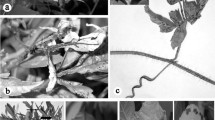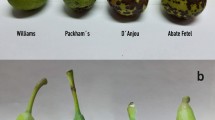Abstract
Studies on the rust fungus Puccinia arechavaletae, were conducted to determine its potential for use as a classical biological control agent against the alien environmental weed Cardiospermum grandiflorum in South Africa. The production of basidiospores is a crucial stage in the life cycle of this microcyclic rust species, and was determined to optimally occur at 20 °C, under high relative humidity (above 90%), in the presence of free water. The first basidiospores were released from mature telia after being incubated for 4 h under optimum conditions, reaching a peak of production after 24 h. Germination of basidiospores optimally occurred at 20 °C, and they were extremely vulnerable to desiccation. Germinating basidiospores directly penetrated epidermal cells of South African C. grandiflorum within which a vesicle formed, followed by rapid radial colonization of the leaf tissue by fungal mycelium. The first symptoms observed were small chlorotic spots on the leaves from 14 days onwards, with telial pustules appearing between 14 and 21 days post inoculation. The rust P. arechavaletae was shown to be highly pathogenic towards South African C. grandiflorum, causing severe disease symptoms with a detrimental effect on plant health and vigor.







Similar content being viewed by others
References
Anning AK, Yeboah-Gyan K (2007) Diversity and distribution of invasive weeds in Ashanti region, Ghana. Afr J Ecol 45:355–360
Batianoff GN, Butler DW (2002) Assessment of invasive naturalized plants in south-East Queensland. Plant Protection Quarterly 17:27–34
Bear V, Ondinea D, Brodie L (2001) Exotic invasions and control: putting bushland weeds into a holding pattern. Ecol Manag Restor 2:76–77
Berner DK, Bruckart WL (2005) A decision tree for evaluation of exotic plant pathogens for classical biological control of introduced invasive weeds. Biol Control 34:222–232
Bruzzese B, Hasan S (1983) A whole leaf clearing and staining technique for host specificity studies of rust fungi. Plant Pathol 32:335–338
Carroll SP, Mathieson M, Loye JE (2005) Invasion history and ecology of the environmental weed balloon vine, Cardiospermum grandiflorum Swartz, in Australia. Plant Protection Quarterly 20:140–144
Dhingra OD, Sinclair JB (1986) Solutions to maintain constant humidity in a closed atmosphere. In: Dhingra OD, Sinclair JB (Eds.) basic plant pathology methods. CRC press, Inc. Boca Raton, Florida, pp. 319-325
Ellison CA, Barreto RW (2004) Prospects for the management of invasive alien weeds using co-evolved fungal pathogens: a Latin American perspective. Biol Invasions 6:23–45
Farr DF, Rossman AY (2018) Fungal databases, systematic mycology and microbiology laboratory, ARS, USDA Available from http://nt.ars-grin.gov/fungaldatabases/ (Accessed 22 January 2018)
Gildenhuys E, Ellis AG, Carroll SP, Le Roux JJ (2013) The ecology, biogeography, history and future of two globally important weeds: Cardiospermum halicacabum L. and C. grandiflorum Sw. NeoBiota 19:45–65 https://doi.org/10.3897/neobiota.19.5279
Global Invasive Species Database (GISD) (2005) Cardiospermum grandiflorum (vine, climber). Available from: http://www.issg.org/database/species/ecology.asp?si=1346&fr=1&sts=&lang=EN (Accessed 18 June 2010)
Harden GJ (2002) Cardiospermum. In: Harden GJ (ed) Flora of new South Wales, vol 2. University of New South Wales Press, Sydney, pp 338–339
Harris CJ, Murray BR, Hose GC, Hamilton MA (2007) Introduction history and invasion success in exotic vines introduced to Australia. Divers Distrib 13:467–475. https://doi.org/10.1111/j.1472-4642.2007.00375.x
Henderson L (2001) Cardiospermum grandiflorum Sw. In: Henderson L (Ed.) Alien weeds and invasive plants: a complete guide to declared weeds and invaders in South Africa. Agricultural Research Council: plant protection research institute, handbook 12, p. 60
Henderson L (2006) Comparisons of invasive plants in southern Africa originating from southern temperate, northern temperate and tropical regions. Bothalia 36:201–222
Hennen JF, Figueiredo MB, De Carvaldo AA, Hennen PG (2005) Catalogue of the species of plant rust fungi (Uredinales) of Brazil. Published online by Instituto de Pesquisas Jardim Botânico do Rio de Janeiro. http://www.jbrj.gov.br (Accessed 8 July 2009)
Johnston SK, Murray DS, Williams JC (1979) Germination and emergence of balloonvine (Cardiospermum halicacabum). Weed Sci 27:73–76
McKay F, Oleiro M, Fourie A, Simelane D (2010) Natural enemies of balloon vine Cardiospermum grandiflorum (Sapindaceae) in Argentina and their potential use as biological control agents in South Africa. Int J Trop Insect Sci 30:67–76. https://doi.org/10.1017/S1742758410000135
Morin L, Edwards PB (2006) Selection of biological control agents for bridal creeper: a retrospective review. Aust J Entomol 45:287–291
Morin L, Auld BA, Brown JF (1993) Host range of Puccinia xanthii and postpenetration development on Xanthium occidentale. Can J Bot 71:959–965
Morin L, Willis AJ, Armstrong J, Kriticos D (2002) Spread, epidemic development and impact of the bridal creeper rust in Australia: summary of results. In: Spafford JH, Dodd J, Moore JH (eds) 13th Australian weeds conference papers and proceedings. Plant Protection Society of WA Inc, Perth, Western Australia, pp 385–388
Morin L, Evans KJ, Sheppard AW (2006a) Selection of pathogen agents in weed biological control: critical issues and peculiarities in relation to arthropod agents. Aust J Entomol 45:349–365
Morin L, Neave M, Batchelor K, Reid A (2006b) Biological control: a promising tool for managing bridal creeper, Asparagus asparagoides (L.) Druce, in Australia. Plant Protection Quarterly 21:69–77
Morris MJ (1991) The use of plant pathogens for biological weed control in South Africa. Agric Ecosyst Environ 37:239–255
Morris MJ, Wood AR, Den Breeyen A (1999) Plant pathogens and biological control of weeds in South Africa: a review of projects and progress during the last decade. Afri Entomol Mem No 1:129–137
Olckers T (2004) Targeting emerging weeds for biological control in South Africa: the benefits of halting the spread of alien plants at an early stage of their invasion. South Afri J Sci 100:64–68
SAS User’s guide. 1999. Statistics, Version 8.2, SAS Institute, Cary, NC, USA
Simelane DO, Fourie A, Mawela KV (2011) Prospective agents for the biological control of Cardiospermum grandiflorum Sw. (Sapindaceae) in South Africa. Afri Entomol 19:269–277. https://doi.org/10.1080/09583157.2014.891002
TeBeest DO, Yang XB, Cisar CR (1992) The status of biological control of weeds with fungal pathogens. Annu Rev Phytopathol 30:637–657
Acknowledgements
We thank the research personnel at the USDA-ARS-South American Biological Control Laboratory in Argentina for their assistance in obtaining isolates of the rust, Puccinia arechavaletae for this study. Financial support for this research project was provided by the Department of Environmental Affairs, Natural Resources Management Programme (DEA:NRMP), South Africa.
Author information
Authors and Affiliations
Corresponding author
Rights and permissions
About this article
Cite this article
Fourie, A., Wood, A.R. The rust fungus Puccinia arechavaletae, a potential biological control agent of balloon vine (Cardiospermum grandiflorum) in South Africa. I: Biology. Australasian Plant Pathol. 47, 379–387 (2018). https://doi.org/10.1007/s13313-018-0569-5
Received:
Accepted:
Published:
Issue Date:
DOI: https://doi.org/10.1007/s13313-018-0569-5




